Luca Corinzia
Breeding Programs Optimization with Reinforcement Learning
Jun 06, 2024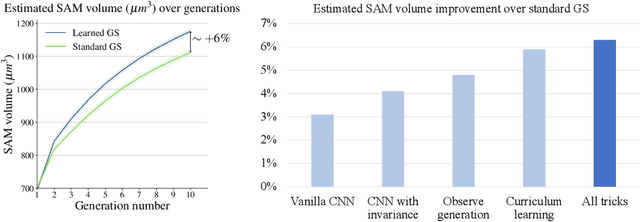
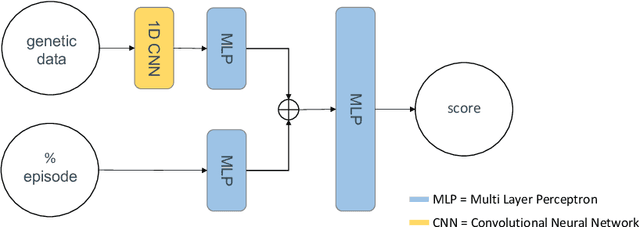
Abstract:Crop breeding is crucial in improving agricultural productivity while potentially decreasing land usage, greenhouse gas emissions, and water consumption. However, breeding programs are challenging due to long turnover times, high-dimensional decision spaces, long-term objectives, and the need to adapt to rapid climate change. This paper introduces the use of Reinforcement Learning (RL) to optimize simulated crop breeding programs. RL agents are trained to make optimal crop selection and cross-breeding decisions based on genetic information. To benchmark RL-based breeding algorithms, we introduce a suite of Gym environments. The study demonstrates the superiority of RL techniques over standard practices in terms of genetic gain when simulated in silico using real-world genomic maize data.
IFedAvg: Interpretable Data-Interoperability for Federated Learning
Jul 14, 2021



Abstract:Recently, the ever-growing demand for privacy-oriented machine learning has motivated researchers to develop federated and decentralized learning techniques, allowing individual clients to train models collaboratively without disclosing their private datasets. However, widespread adoption has been limited in domains relying on high levels of user trust, where assessment of data compatibility is essential. In this work, we define and address low interoperability induced by underlying client data inconsistencies in federated learning for tabular data. The proposed method, iFedAvg, builds on federated averaging adding local element-wise affine layers to allow for a personalized and granular understanding of the collaborative learning process. Thus, enabling the detection of outlier datasets in the federation and also learning the compensation for local data distribution shifts without sharing any original data. We evaluate iFedAvg using several public benchmarks and a previously unstudied collection of real-world datasets from the 2014 - 2016 West African Ebola epidemic, jointly forming the largest such dataset in the world. In all evaluations, iFedAvg achieves competitive average performance with negligible overhead. It additionally shows substantial improvement on outlier clients, highlighting increased robustness to individual dataset shifts. Most importantly, our method provides valuable client-specific insights at a fine-grained level to guide interoperable federated learning.
On maximum-likelihood estimation in the all-or-nothing regime
Jan 25, 2021Abstract:We study the problem of estimating a rank-1 additive deformation of a Gaussian tensor according to the \emph{maximum-likelihood estimator} (MLE). The analysis is carried out in the sparse setting, where the underlying signal has a support that scales sublinearly with the total number of dimensions. We show that for Bernoulli distributed signals, the MLE undergoes an \emph{all-or-nothing} (AoN) phase transition, already established for the minimum mean-square-error estimator (MMSE) in the same problem. The result follows from two main technical points: (i) the connection established between the MLE and the MMSE, using the first and second-moment methods in the constrained signal space, (ii) a recovery regime for the MMSE stricter than the simple error vanishing characterization given in the standard AoN, that is here proved as a general result.
Statistical and computational thresholds for the planted $k$-densest sub-hypergraph problem
Nov 23, 2020
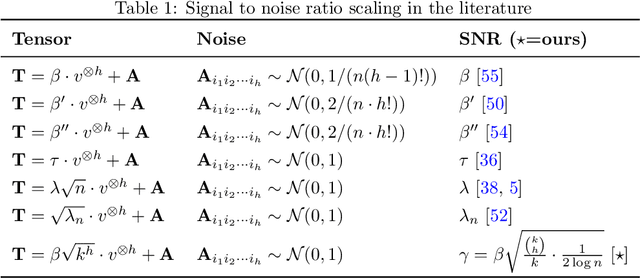
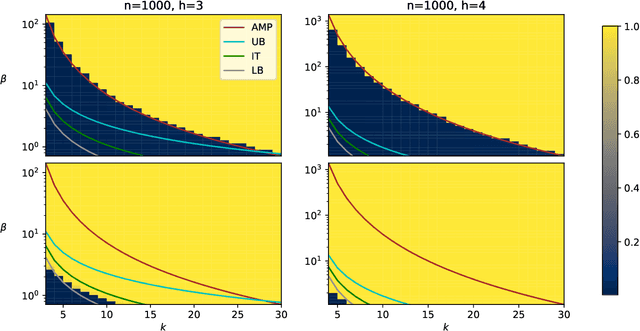
Abstract:Recovery a planted signal perturbed by noise is a fundamental problem in machine learning. In this work, we consider the problem of recovery a planted $k$-densest sub-hypergraph on $h$-uniform hypergraphs over $n$ nodes. This fundamental problem appears in different contexts, e.g., community detection, average case complexity, and neuroscience applications. We first observe that it can be viewed as a structural variant of tensor PCA in which the hypergraph parameters $k$ and $h$ determine the structure of the signal to be recovered when the observations are contaminated by Gaussian noise. In this work, we provide tight information-theoretic upper and lower bounds for the recovery problem, as well as the first non-trivial algorithmic bounds based on approximate message passing algorithms. The problem exhibits a typical information-to-computational-gap observed in analogous settings, that widens with increasing sparsity of the problem. Interestingly, the bounds show that the structure of the signal does have an impact on the existing bounds of tensor PCA that the unstructured planted signal does not capture.
Neural collaborative filtering for unsupervised mitral valve segmentation in echocardiography
Aug 13, 2020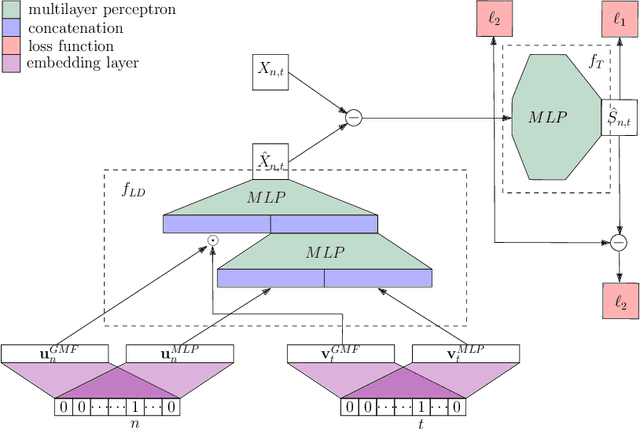
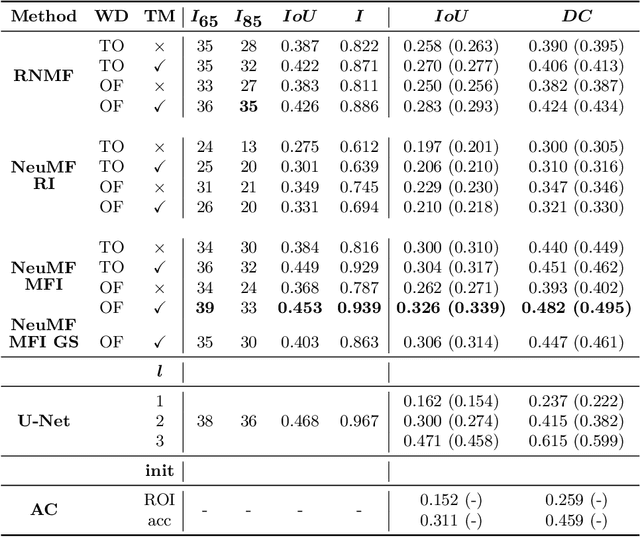
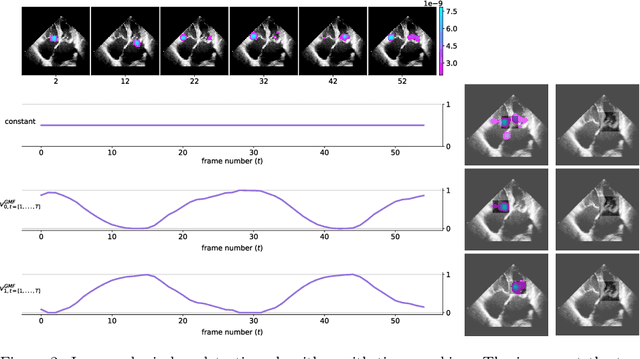
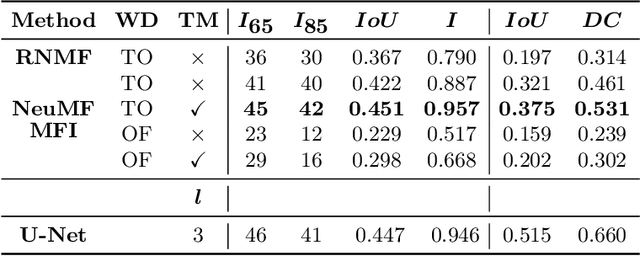
Abstract:The segmentation of the mitral valve annulus and leaflets specifies a crucial first step to establish a machine learning pipeline that can support physicians in performing multiple tasks, e.g.\ diagnosis of mitral valve diseases, surgical planning, and intraoperative procedures. Current methods for mitral valve segmentation on 2D echocardiography videos require extensive interaction with annotators and perform poorly on low-quality and noisy videos. We propose an automated and unsupervised method for the mitral valve segmentation based on a low dimensional embedding of the echocardiography videos using neural network collaborative filtering. The method is evaluated in a collection of echocardiography videos of patients with a variety of mitral valve diseases, and additionally on an independent test cohort. It outperforms state-of-the-art \emph{unsupervised} and \emph{supervised} methods on low-quality videos or in the case of sparse annotation.
Variational Federated Multi-Task Learning
Jun 14, 2019



Abstract:In classical federated learning a central server coordinates the training of a single model on a massively distributed network of devices. This setting can be naturally extended to a multi-task learning framework, to handle real-world federated datasets that typically show strong non-IID data distributions among devices. Even though federated multi-task learning has been shown to be an effective paradigm for real world datasets, it has been applied only to convex models. In this work we introduce VIRTUAL, an algorithm for federated multi-task learning with non-convex models. In VIRTUAL the federated network of the server and the clients is treated as a star-shaped Bayesian network, and learning is performed on the network using approximated variational inference. We show that this method is effective on real-world federated datasets, outperforming the current state-of-the-art for federated learning.
A Spectral Method for Activity Shaping in Continuous-Time Information Cascades
Sep 15, 2017


Abstract:Information Cascades Model captures dynamical properties of user activity in a social network. In this work, we develop a novel framework for activity shaping under the Continuous-Time Information Cascades Model which allows the administrator for local control actions by allocating targeted resources that can alter the spread of the process. Our framework employs the optimization of the spectral radius of the Hazard matrix, a quantity that has been shown to drive the maximum influence in a network, while enjoying a simple convex relaxation when used to minimize the influence of the cascade. In addition, use-cases such as quarantine and node immunization are discussed to highlight the generality of the proposed activity shaping framework. Finally, we present the NetShape influence minimization method which is compared favorably to baseline and state-of-the-art approaches through simulations on real social networks.
 Add to Chrome
Add to Chrome Add to Firefox
Add to Firefox Add to Edge
Add to Edge